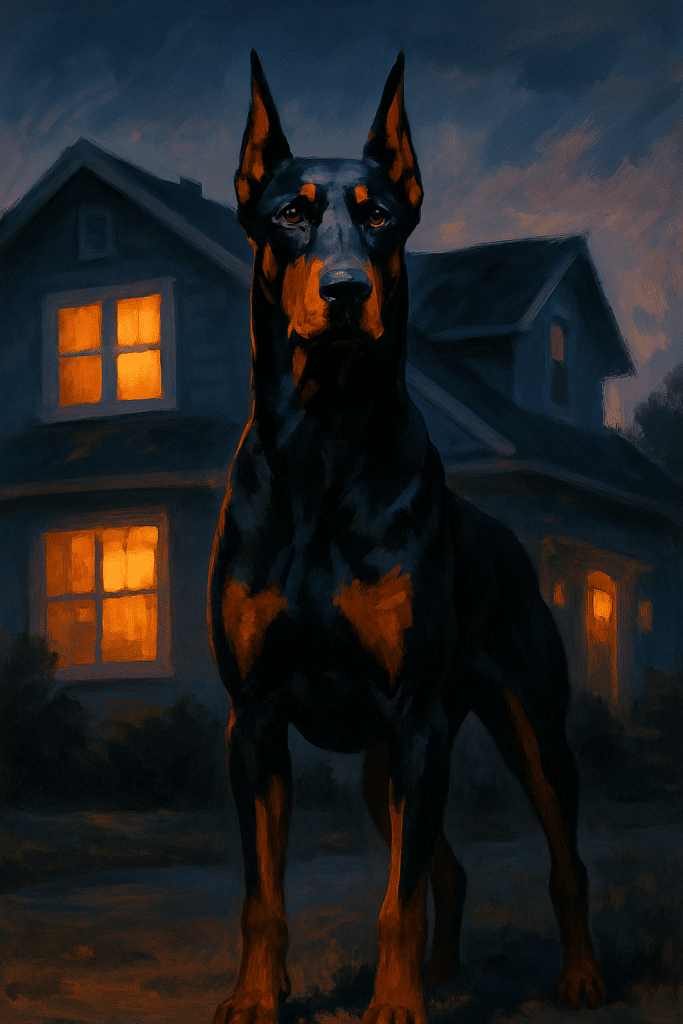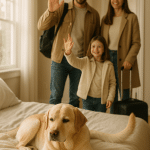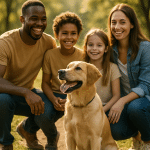Introduction: The Crucial Role of Guard Dog Breeds in Family Safety and Property Protection
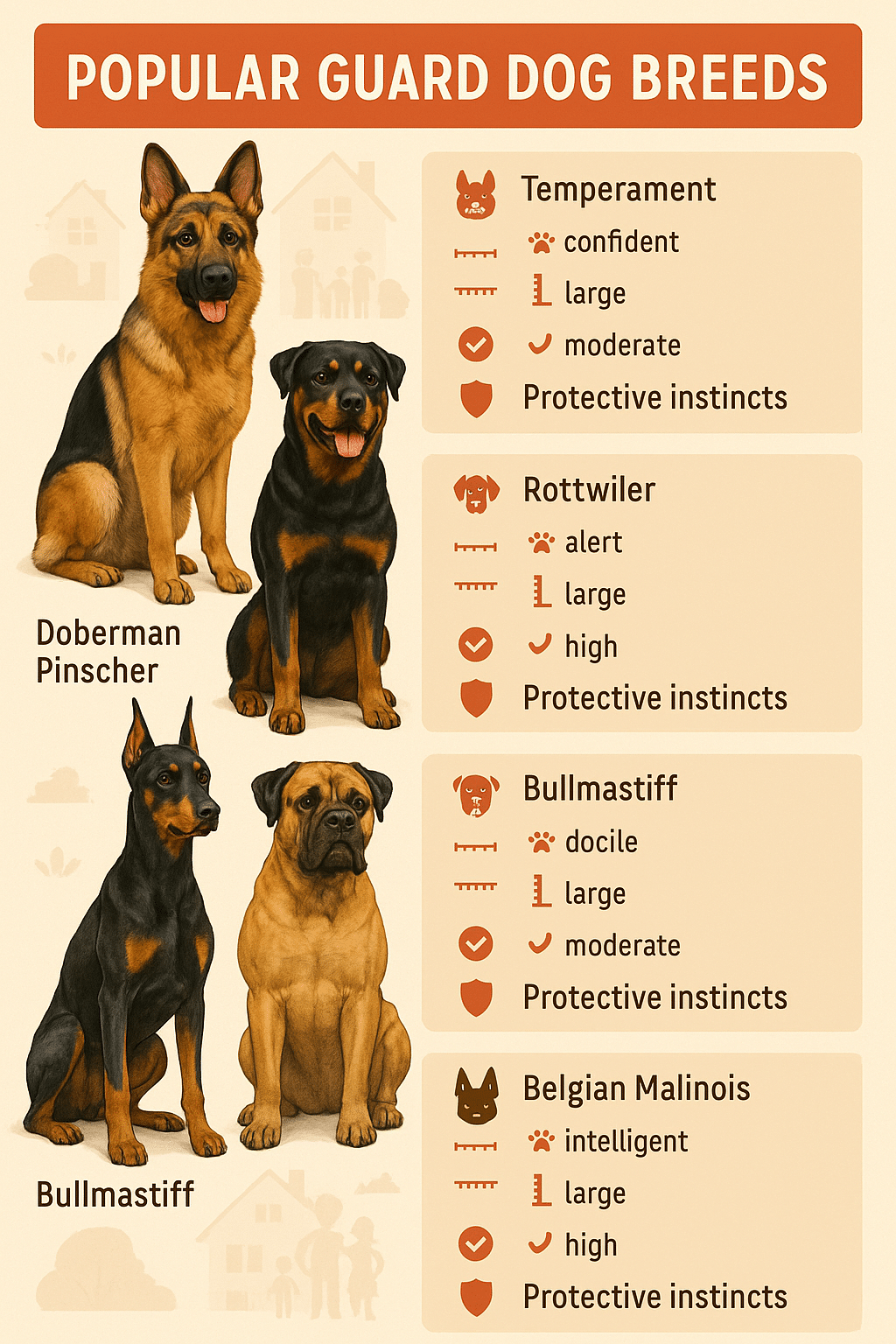
When it comes to protecting your home and loved ones, few measures are as reassuring and dependable as having a trustworthy guard dog by your side. Guard dog breeds have been selectively developed over centuries to provide vigilant protection, displaying remarkable loyalty and sharp instincts that help deter intruders and safeguard family members. As a pet owner or family seeking guidance on the best breeds and training approaches, understanding how these powerful animals operate is essential.
In this extensive article, we’ll explore the guard dog breeds that stand out not only for their protective nature but also for their ability to integrate well within family environments. We will dive deep into temperament and protective instincts, unearth the traits of the top 5 guard dog breeds, and provide practical advice on training, socialization, health, and maintenance. Whether you’re a first-time dog owner, looking for a low-maintenance protector, or interested in breeds suitable for apartment living, this guide has you covered. Let’s embark on the journey toward finding the perfect protective companion for your home.
Understanding Canine Temperament and Protective Instincts for Guard Dog Selection
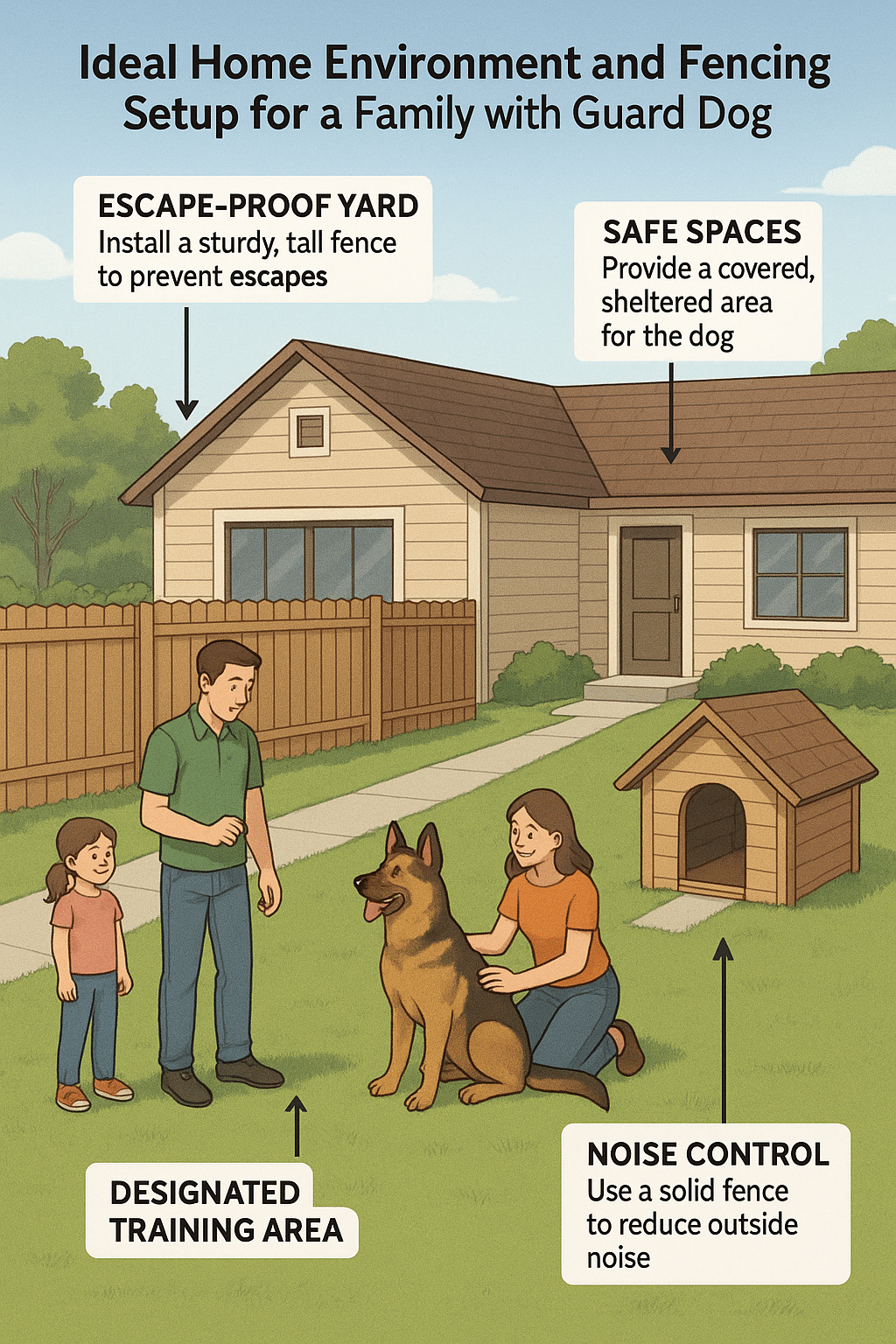
Selecting from among various guard dog breeds requires a nuanced understanding of canine temperament — that mix of genetics, personality, and social influences that shape a dog’s behavior. Temperament isn’t just about aggression or fear; it encompasses a dog’s emotional stability, willingness to obey commands, and capacity for social interactions, all essential when raising a family-friendly guardian.
How Temperament Impacts Family-Friendly Guard Dog Breeds
Temperament profoundly influences how well a guard dog functions around children, visitors, and other pets. For families, a breed exhibiting balanced characteristics — such as calmness, patience, and protective vigilance without unnecessary aggression — is ideal. Dogs like the German Shepherd and Akita showcase manageable temperaments that allow them to be both protectors and companions. A dog’s reaction to unfamiliar situations or people must be predictable and controllable to ensure it remains a safe member of the household while fulfilling its protective duties.
Assessing Protective Instinct Versus Aggression in Guard Dogs
One of the trickiest factors to balance is a dog’s innate protective instinct, which motivates guarding behaviors, versus overt aggression, which can be dangerous and counterproductive. Protective instincts manifest as alertness, territorial defense, and loyalty, triggering responses to potential threats. However, excessive aggression can lead to unwarranted attacks or behavioral problems. Reputable breeders and trainers emphasize selecting dogs whose protective drives are controllable through consistent training and early socialization techniques, thus guaranteeing they respond appropriately when security is truly needed.
Top 5 Guard Dog Breeds for Families and Home Security
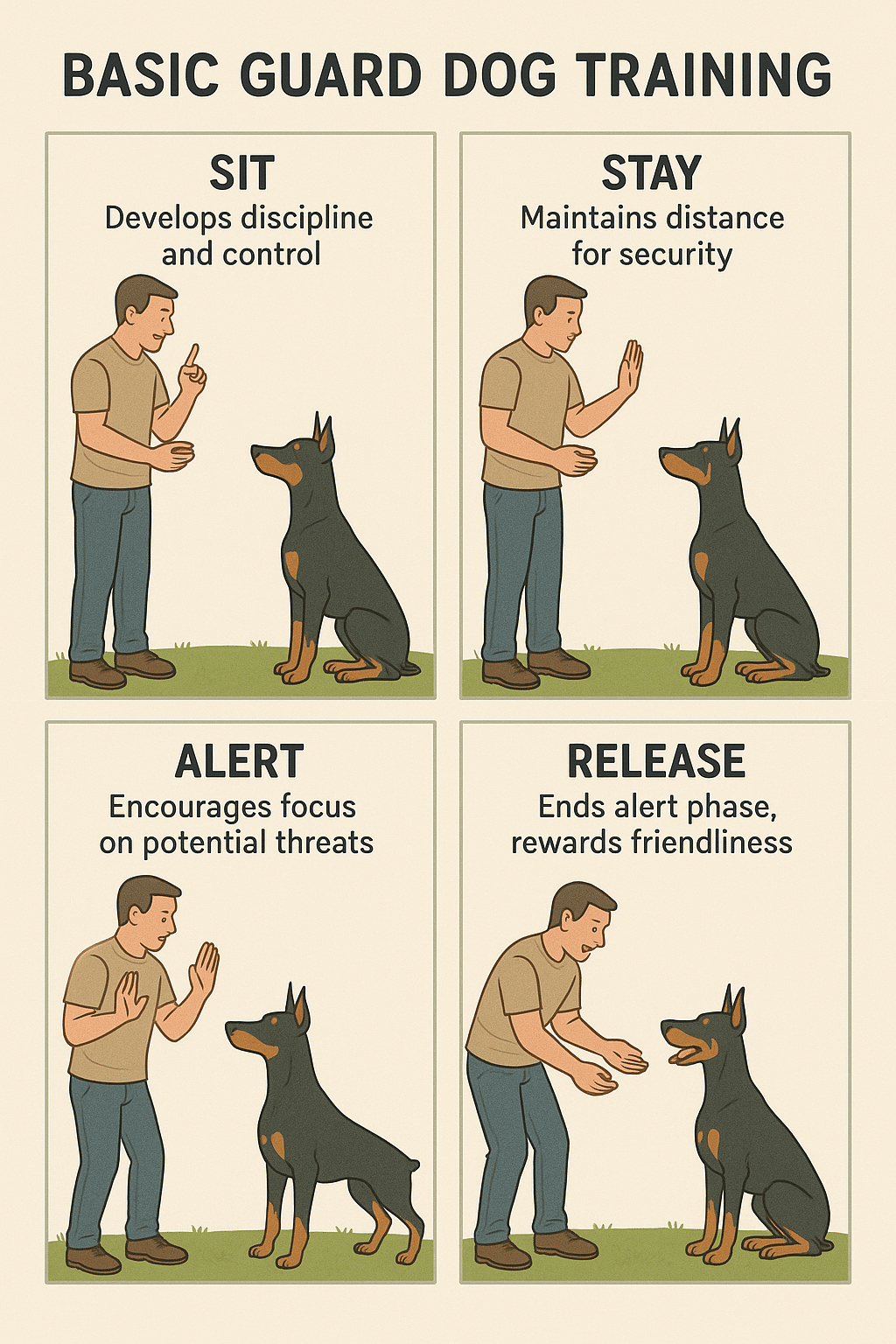
German Shepherd: Balanced Intelligence and Loyalty for Protection and Companionship
The German Shepherd is often the first breed that comes to mind when considering top guard dog breeds for home security. Celebrated for its high intelligence, trainability, and unwavering loyalty, the German Shepherd strikes a perfect balance between a fierce protector and a loving family member.
Physical Characteristics and Suitability for Apartment Versus Large Homes
Typically weighing between 50 and 90 pounds with a strong, muscular build, German Shepherds possess the stamina for both outdoor security duties and indoor companionship. While they thrive on space to roam, with proper daily exercise and mental stimulation, they can adapt to apartment living in larger cities. Their double coat requires seasonal grooming but isn’t overly demanding. Families living in suburban or rural areas will appreciate the breed’s versatility in size and energy, making it suitable for large properties.
Training Tips Focused on Obedience and Socialization
Given their intelligence, German Shepherds respond exceptionally well to obedience training. Initiate training from a young age using positive reinforcement; this includes treats, praise, and play. Early socialization — exposing your puppy to various people, sounds, and environments — is crucial for preventing fear-based aggression. To enhance their guarding effectiveness, integrate commands that promote alertness yet ensure calmness on cue. Consistent training sessions combined with mental challenges, such as interactive toys or scent-based tasks, keep these guardians sharp and well-behaved.
Rottweiler: Powerful and Protective with a Gentle Family-Oriented Side
The Rottweiler is another powerhouse among large guard dog breeds for property protection. With a reputation for strength and confidence, Rottweilers excel in guarding homes and families. Despite their imposing presence, when properly raised, they exhibit remarkable gentleness and affection toward children and close family.
Managing Aggression Levels to Ensure Safe Interactions with Children and Pets
The key to owning a safe and friendly Rottweiler lies in managing its natural boldness. Rottweilers have a protective nature but can display territorial aggression if not socialized from puppyhood. Consistent training that clearly establishes boundaries helps keep aggression in check. Exposure to children and other pets gradually builds tolerance and reduces fear or dominance behaviors. Early obedience classes, combined with positive social interactions, are highly recommended to cultivate a balanced temperament.
Exercise and Grooming Requirements for Maintaining Well-Being
Rottweilers need moderate to high daily exercise, including long walks, play sessions, and mental engagement to prevent boredom and destructive behavior. They have a short to medium-length coat, requiring only weekly brushing to remove loose hair and maintain skin health. Their robust build requires monitoring for hip dysplasia and joint health, a breed-specific concern that responsible breeders test for.
Doberman Pinscher: Agile, Alert, and Highly Trainable Family Guardian
Doberman Pinschers rank high among intelligent guard dog breeds for first-time owners due to their alertness and eagerness to please. Agile and sleek, Dobermans combine speed and strength, making them effective protectors who adapt well to family life.
Socialization Techniques to Curb High Energy and Alertness
This breed’s high energy levels mean it can become overly vigilant or excitable without proper outlets. Structured socialization from the earliest stages helps keep Dobermans balanced: introducing them to various people, animals, and environments defuses potential wariness of strangers. Mental stimulation through advanced obedience or agility training channels their energy constructively, preventing nuisance barking or destructive tendencies.
Suitable Training Methods for First-Time Owners
Dobermans thrive on positive reinforcement tactics paired with consistent rules and boundaries. First-time owners are advised to join professional training classes to build a strong foundation, especially since the breed’s assertive nature requires confident handling. Clear communication and routine ensure the Doberman matures into a calm yet protective guardian.
Akita: Independent and Loyal Breed with Strong Protective Instincts
Known for its dignified presence and powerful guarding instincts, the Akita offers a unique blend of independence and loyalty. This breed is ideal for families seeking a watchful companion that displays reserved affection within a personal circle.
Considerations for Apartment Living and Family Integration
Akitas are larger dogs with a thick double coat, weighing between 70 and 120 pounds. They produce a significant amount of shedding, particularly during seasonal changes, requiring regular grooming to manage. While Akitas can live in apartments, they demand rigorous daily exercise to avoid pent-up energy. They tend to be wary of strangers, so integrating them into families with children must be done carefully, with attention to early socialization.
Unique Challenges in Training and Temperament Management
Akitas often exhibit independence and stubbornness, which can complicate training. Owners must exercise patience and maintain firm but kind leadership. Socialization is perhaps more crucial with this breed to prevent territorial behaviors. Nevertheless, once bonded, Akitas are fiercely protective, often assuming natural guardian roles in their homes.
Belgian Malinois: Intelligent and Energetic Working Dog for Experienced Families
The Belgian Malinois is famed in working dog circles — especially with police and military — for its razor-sharp intelligence and relentless drive. For families equipped to handle a highly energetic dog, the Malinois excels as a vigilant protector.
High Energy and Alertness Demands: Meeting Exercise Needs
Malinois require intense physical and mental exercise daily to stave off boredom-induced behavior issues. They thrive on activities like running, herding, agility, and scent training, making them suited to active families or those with working dog experience. Without adequate stimulation, they risk becoming destructive or hyperactive.
Socialization and Obedience Training to Prevent Aggression
Early, frequent socialization is vital to curb the Malinois’s natural suspicion of strangers. Professional obedience training is also recommended to channel their protective instinct into disciplined guarding rather than unnecessary aggression. Ongoing reinforcement and engagement build an obedient companion who serves as a confident protector without compromising family safety.
Selecting the Right Guard Dog Breed Based on Family Lifestyle and Environment
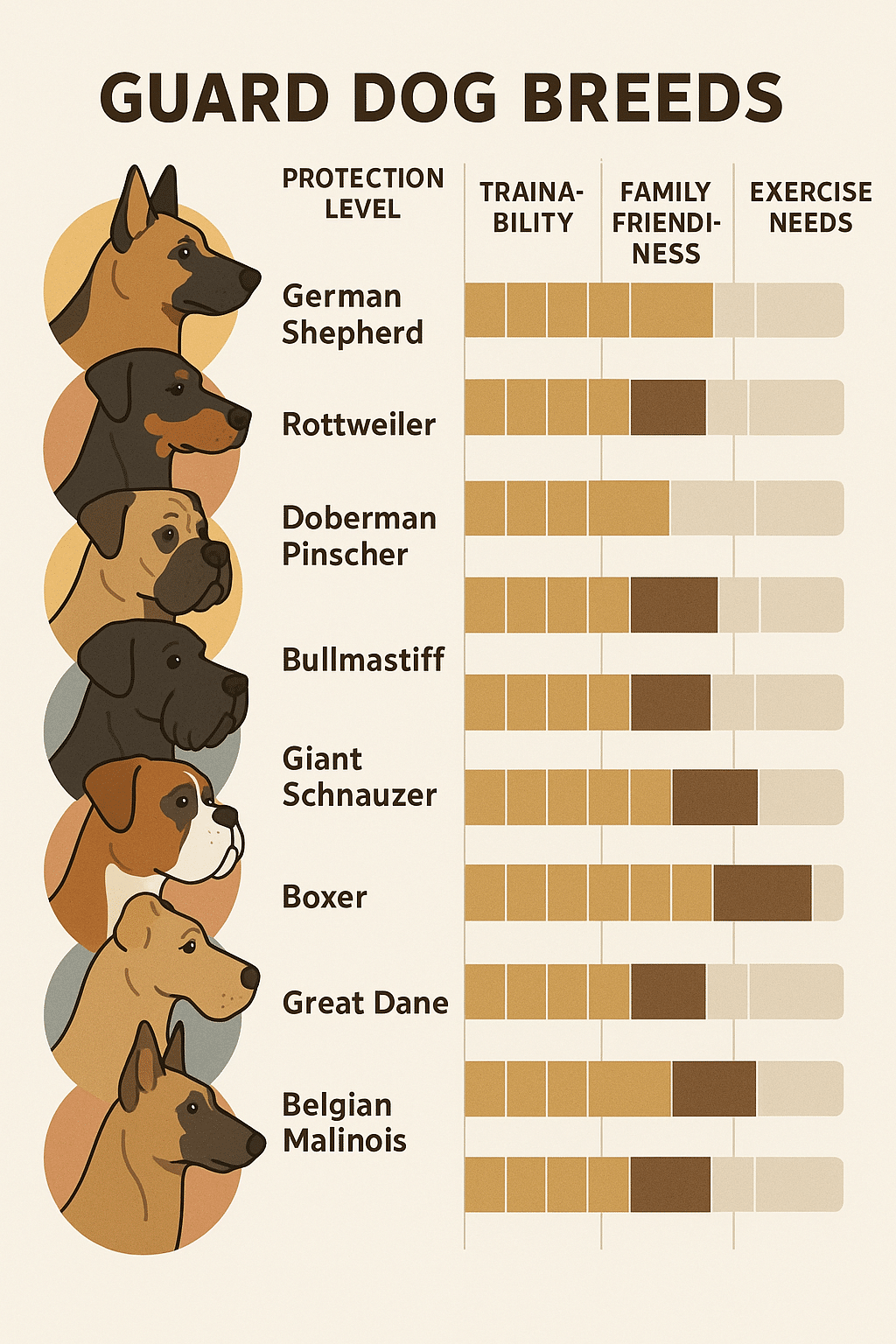
Best Guard Dog Breeds for Families with Children
Families often seek family-friendly guard dog breeds with protective instincts that can harmonize with children. German Shepherds and Rottweilers often top this list for their combination of patience, loyalty, and protective prowess. Early socialization and supervised interactions ensure children and dogs develop a safe bond, minimizing risks.
Low-Maintenance Guard Dog Breeds Suitable for Beginners
If you’re new to dog ownership, consider breeds like the Doberman Pinscher or German Shepherd, noted in the guard dog breeds that are easy to train category. These dogs respond well to clear, consistent training and support a joyful learning experience for first-time owners. Their moderate grooming needs and general health make them manageable choices.
Guard Dog Breeds Adapted for Apartment Living and Smaller Properties
While many guard dog breeds prefer larger spaces, some adapt well to smaller homes, especially with dedicated exercise routines. The German Shepherd and even Akita can fit into apartment life when exercised regularly. These options appear in guard dog breeds suitable for apartment living — a key consideration for urban families focusing on security without sacrificing living space.
Essential Training and Socialization Practices for Guard Dog Breeds
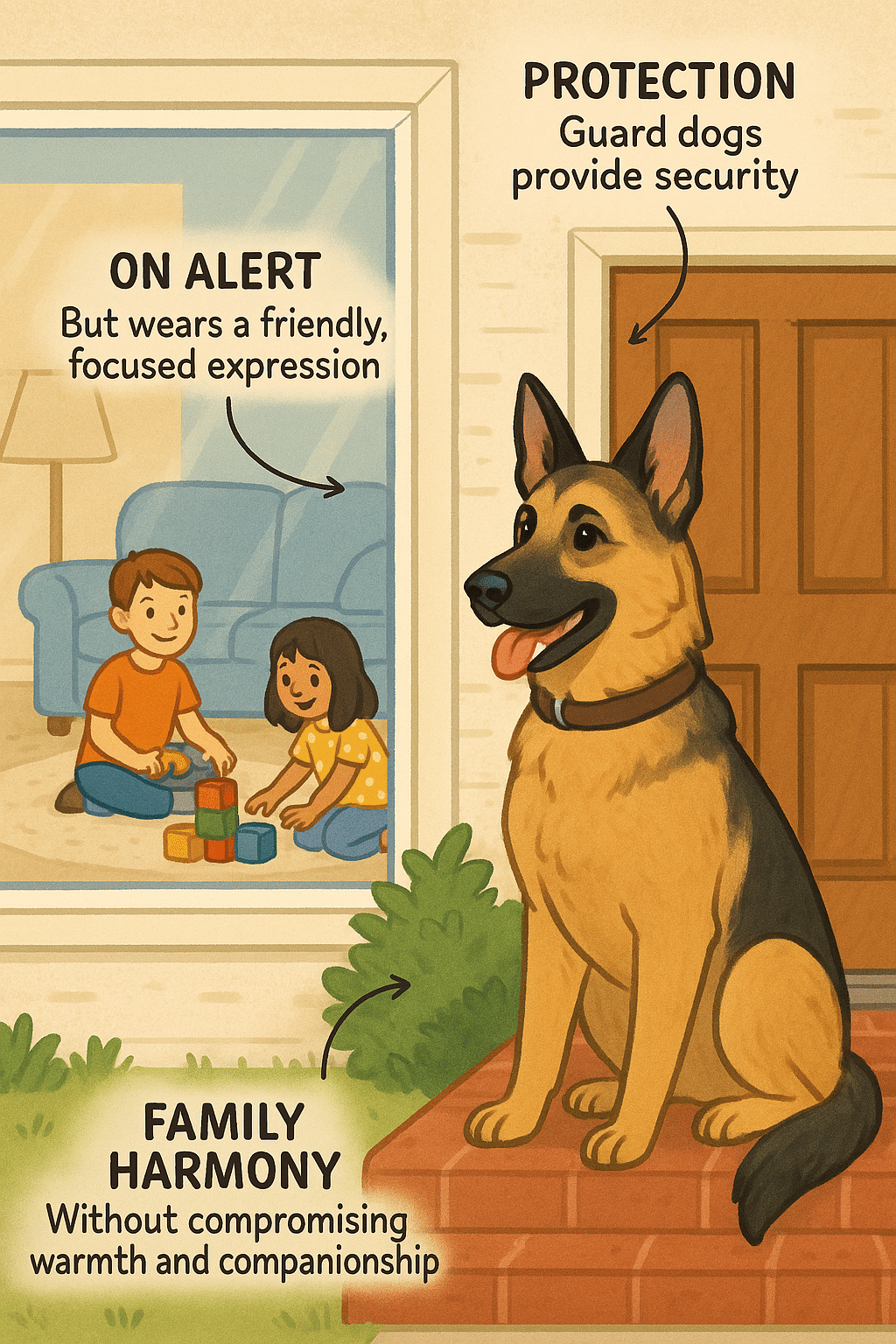
Puppy Training Techniques to Foster Protective but Calm Behavior
Starting training early is pivotal in shaping guard dogs into calm, reliable protectors. This involves positive reinforcement methods, establishing clear house rules, and regular exposure to different environments and people. Teaching commands like “sit,” “stay,” “quiet,” and “leave it” control reactive instincts and channel protective behaviors appropriately.
Managing Aggression and Enhancing Family Pet Safety
Guard dogs naturally possess protective drives but must be guided to avoid unnecessary aggression. Techniques like desensitization and gradual exposure to stimuli reduce fear-based reactions. Owners should monitor body language and intervene proactively if stress signs emerge. Regular obedience exercises contribute to a well-mannered dog who guards without endangering innocent visitors or family.
The Importance of Early Socialization for Guard Dogs
Socialization is the cornerstone of balanced temperament, involving controlled introductions to dogs, animals, and strangers from puppyhood. Doing so prevents territorial or fearful reactions, key to integrating guard dogs safely into family life. Socially skilled dogs excel as guardians while remaining approachable companions.
Health, Grooming, and Maintenance Considerations for Guard Dog Breeds
Breed-Specific Health Issues and Preventive Care
Each guard dog breed comes with unique health considerations. For example, German Shepherds are prone to hip dysplasia and degenerative myelopathy, whereas Dobermans may face heart conditions like dilated cardiomyopathy. Regular veterinary check-ups, quality nutrition, and genetic testing from reputable breeders help prevent and manage these issues.
Grooming Needs Aligned with Protective Coat Types
Guard dogs feature various coat types — from the short, dense coats of Rottweilers to the thick double coats of Akitas — influencing grooming needs. Weekly brushing keeps coats healthy and reduces shedding. Seasonal shedding calls for extra care during transitions. Cleanliness also supports general well-being and alertness, integral for a dog’s guarding duties.
Integrating Guard Dog Breeds into a Family Setting: Ensuring Harmony and Security
Compatibility with Other Pets and Family Members
Before choosing a breed, assess how well it interacts with current pets and family dynamics. Breeds like the German Shepherd tend to be social and accepting of other animals when introduced properly. Akitas require more caution due to strong prey drive and independence. Supervised introductions and consistent training foster peaceful coexistence.
Establishing Boundaries and Routines for Effective Guarding
Guard dogs flourish under clear structure. Setting daily routines for feeding, walking, training, and rest reinforces security roles while maintaining calmness. Defining off-limits areas and consistent reinforcement of house rules prevents over-guarding or anxiety, creating a balanced environment for both the dog and family members.
Guard Dog Breeds in Police, Military, and Working Roles: What Families Can Learn
Traits That Make These Breeds Exceptional Working Dogs
Many top guard dog breeds used by police and military possess traits like acute intelligence, high trainability, and intense focus under stress. Breeds such as Belgian Malinois and German Shepherds exemplify these qualities, highlighting the importance of mental discipline paired with physical conditioning.
Applying Professional Training Insights to Home Protection
Owners can borrow from professional training techniques — such as reward-based learning, scenario simulations, and impulse control exercises — to cultivate emotionally stable protectors. These approaches ensure dogs remain alert and responsive without being reactive, crucial for effective home security.
Responsible Ownership: Ethics, Commitment, and Lifelong Care for Guard Dogs
Understanding the Responsibility of Owning a Protective Breed
Owning a guard dog breed demands dedication to lifelong training, health monitoring, and socialization. These dogs require consistent mental and physical engagement to thrive and protect appropriately. Owners must commit not just to protection, but also to nurturing the dog as a family member.
Legal and Safety Considerations for Guard Dog Owners
It’s important to understand local laws concerning guard dogs, such as liability regulations or breed restrictions. Safety protocols — like secure fencing, proper leashing, and clear signage — protect both the dog and visitors. Responsible ownership ensures your protective dog remains an asset, not a liability.
Conclusion: Making an Informed Choice for Your Family’s Safety and Companionship
Selecting the right guard dog breeds for your family’s protection is more than picking the strongest or most intimidating dog; it’s about finding a loyal, well-mannered companion who integrates safely into your home and lifestyle. By understanding temperament, protective instincts, training needs, and health considerations, you’re empowered to make an informed choice that delivers both security and love.
From the versatile German Shepherd to the energetic Belgian Malinois, each breed presented here offers unique strengths tailored to different family dynamics. Remember, consistent training, socialization, and responsible care are your best tools to cultivate a dedicated protector who also waxes your best friend.
If you’re ready to bring a powerful, family-friendly guardian into your life, start today by researching reputable breeders or rescue organizations, and consider consulting professional trainers to set the foundation for success. Your journey toward safeguarding your home with a trusted guard dog breed begins now—and I promise, the companionship and peace of mind will be well worth the effort.
FAQs
Q1: What are the best guard dog breeds for families with children?
A1: Breeds like German Shepherds and Rottweilers are excellent choices due to their balanced protective instincts and gentle nature with kids, especially when socialized early.
Q2: Which guard dog breeds are easiest to train?
A2: The Doberman Pinscher and German Shepherd rank high for trainability, responding well to consistent positive reinforcement and routine.
Q3: Can guard dog breeds live comfortably in apartments?
A3: Some can, such as German Shepherds and Akitas, provided they receive sufficient daily exercise and mental stimulation to channel their energy.
Q4: How do I prevent my guard dog from becoming aggressive?
A4: Early socialization combined with obedience training and clearly defined boundaries helps manage aggression and ensures your dog remains calm and protective without being dangerous.
Q5: Are guard dog breeds good with other pets?
A5: Many guard dog breeds, including German Shepherds and Rottweilers, coexist well with other pets when introduced properly and socialized from a young age, though some breeds like Akitas require more careful management.
Quick Takeaways/Key Points
- Guard dog breeds balance protective instincts with family-friendly temperaments when properly socialized.
- German Shepherds and Rottweilers offer versatility for both family companionship and home security.
- Early training focusing on obedience, socialization, and impulse control is crucial for all guard dog breeds.
- Exercise, grooming, and health monitoring vary by breed but remain essential to overall well-being.
- Understanding legal responsibilities and safety measures ensures compliant, responsible ownership.
- Active breeds like Belgian Malinois require experienced owners ready to meet high energy demands.
- Establishing clear boundaries and routines fosters calm, effective guardians who protect without unnecessary aggression.

